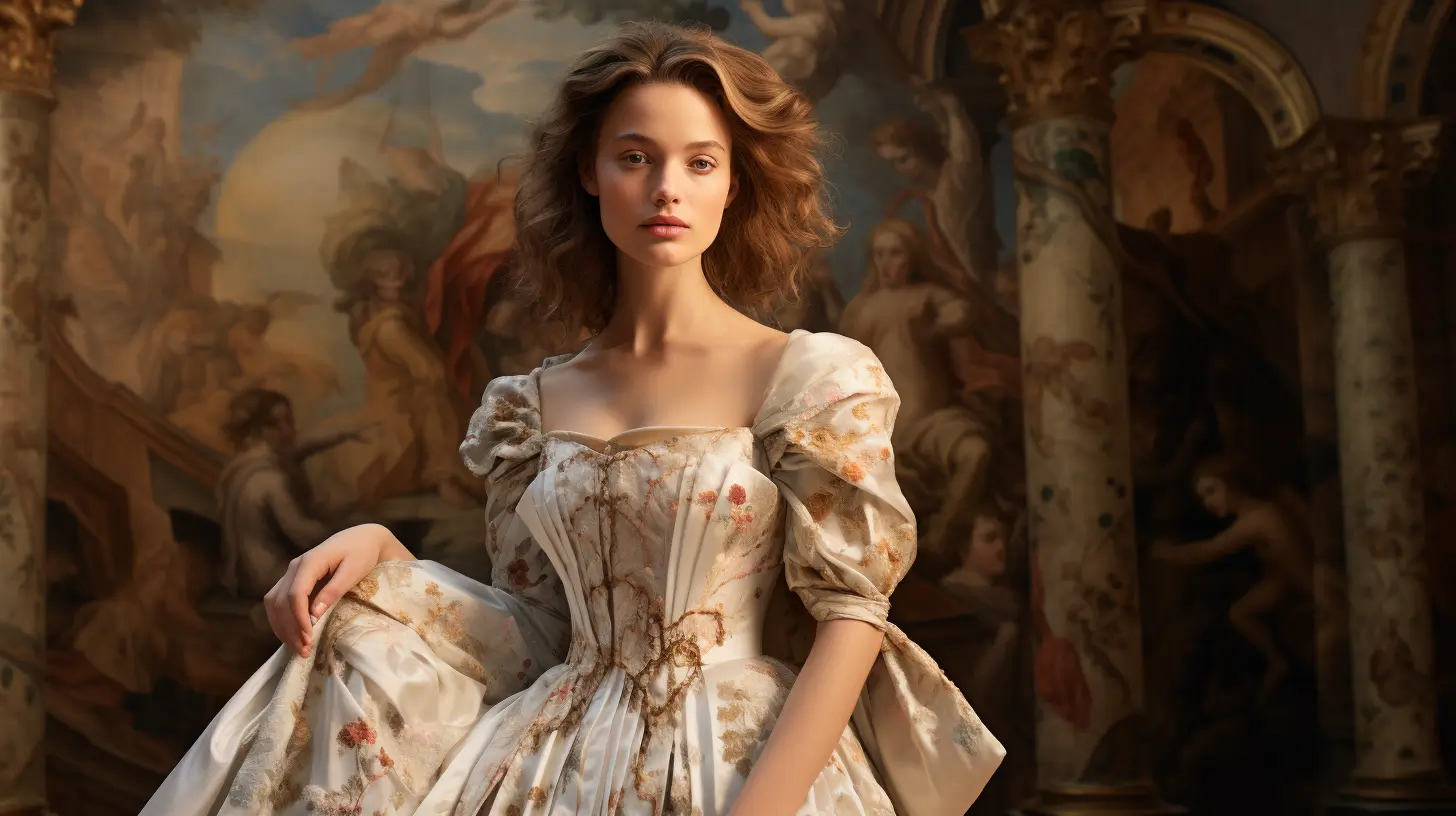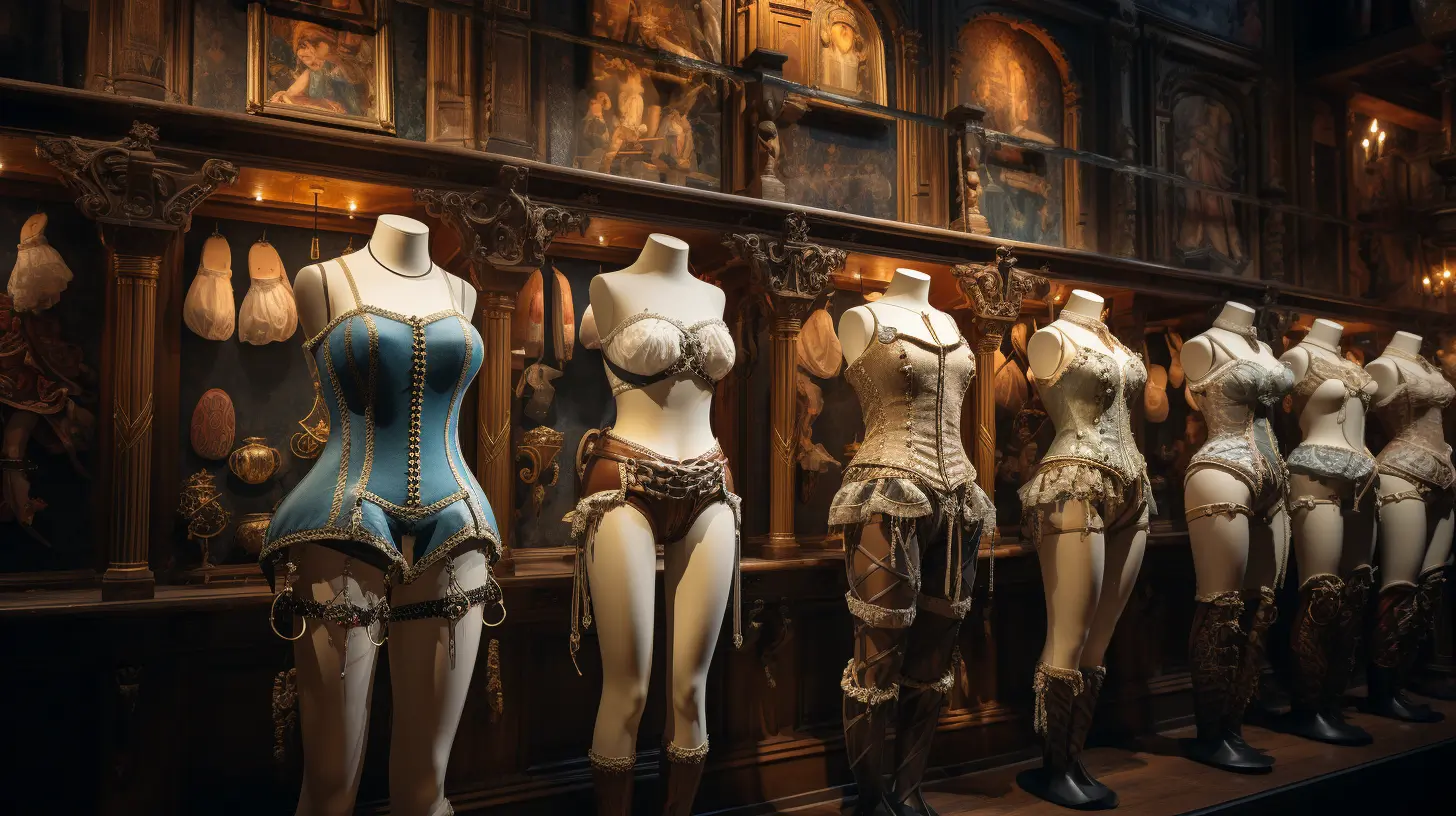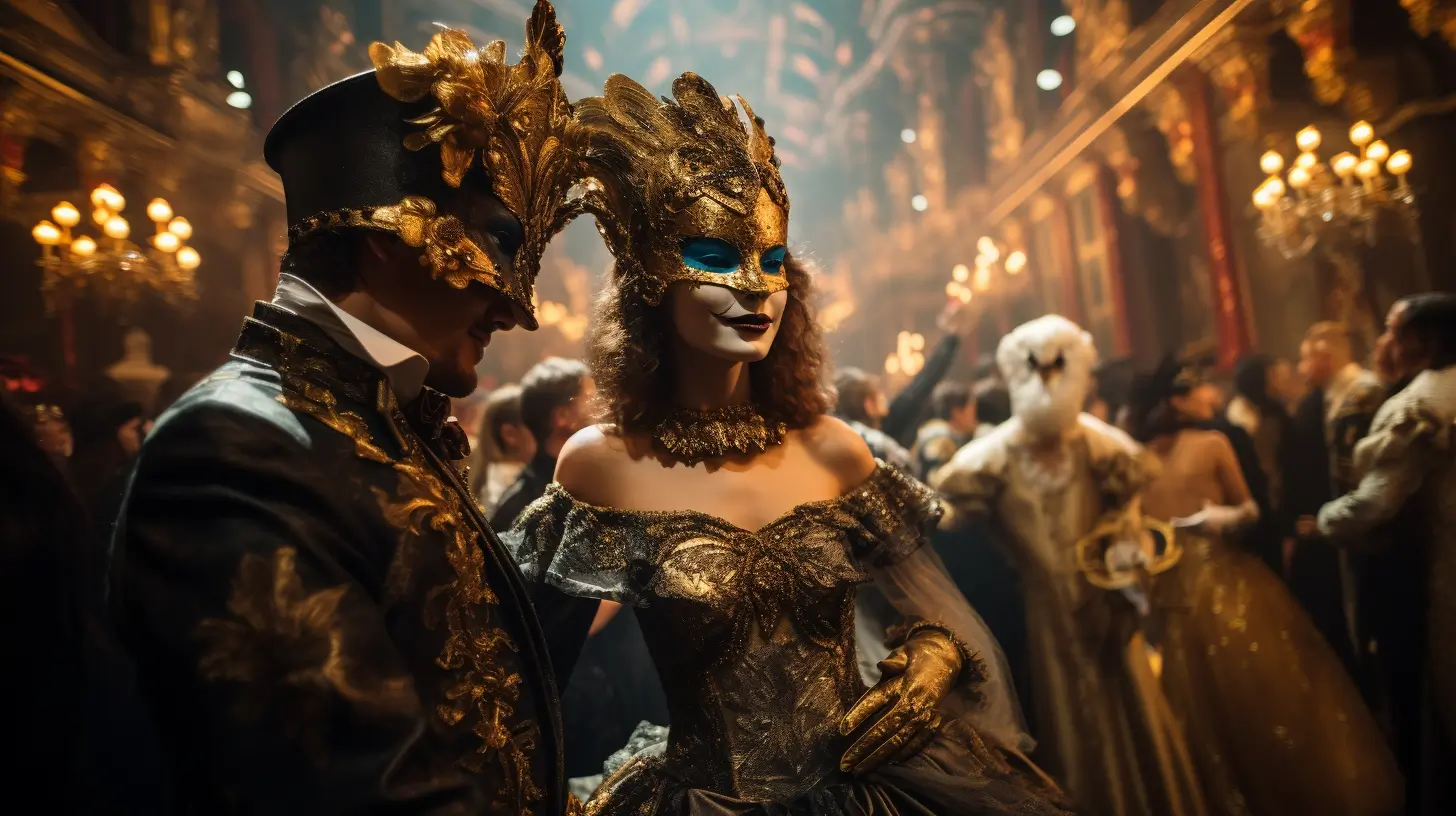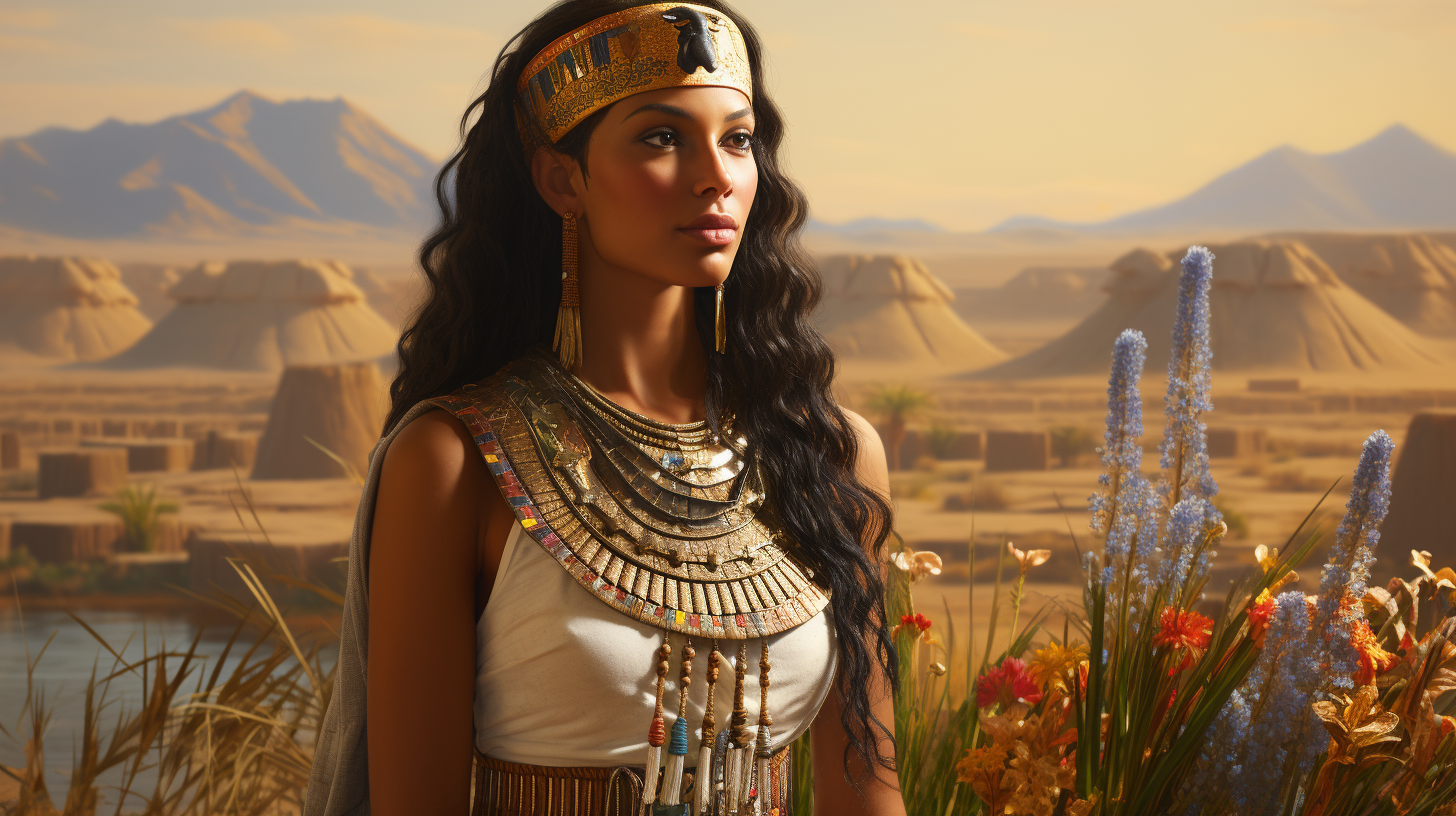
The Allure of the Nile: A Journey into Ancient Egyptian Glamour 🌟
Welcome, fashion history enthusiasts and curious souls! Prepare to be transported back in time, to a land of endless deserts, majestic pyramids, and the life-giving Nile River. Today, we’re diving deep into the world of Egyptian fashion and Ancient Nile Valley clothing, a subject that continues to captivate and inspire designers, historians, and fashionistas alike. 🌿🏺
Imagine walking through a bustling marketplace in ancient Thebes, the air filled with the scent of exotic spices and oils. Men and women pass by, draped in garments that flow like water, adorned with intricate jewelry that sparkles in the Egyptian sun. The fashion of this bygone era was not just about clothing; it was a complex tapestry interwoven with social, religious, and cultural threads. 🌈

So, why does Egyptian fashion hold such a timeless allure? Is it the luxurious fabrics, the opulent jewelry, or the deep-rooted cultural significance? The answer is all of the above and more. As we peel back the layers, you’ll discover that Egyptian fashion is a mirror reflecting the society’s values, beliefs, and even its hierarchical structure. 🌟
In this comprehensive exploration, we’ll delve into everything from the iconic linen garments and elaborate jewelry to the cultural and social aspects that make Egyptian fashion a fascinating subject of study. So, buckle up your metaphorical sandals and get ready for an enlightening journey down the Nile! 🚤
Unveiling the Mysteries: The Timeless Allure of Egyptian Fashion 🌟
Ah, the land of the Pharaohs, pyramids, and the majestic Nile! A civilization that has long captivated our imagination, not just for its monumental achievements in architecture and governance, but also for its indelible impact on fashion. Today, we’re setting our sights on the mesmerizing world of Egyptian fashion and Ancient Nile Valley clothing. 🌿🏺
Picture yourself strolling through the grand halls of an ancient Egyptian palace. The walls are adorned with intricate hieroglyphs and frescoes, but what truly catches your eye is the elegance of the people. Men and women draped in garments that seem to have been kissed by the sun, their jewelry a dazzling array of gold and gemstones that reflect the rich palette of the Nile Valley. The fashion of this era was far from mere vanity; it was a complex language, a form of expression steeped in cultural, social, and even religious significance. 🌈
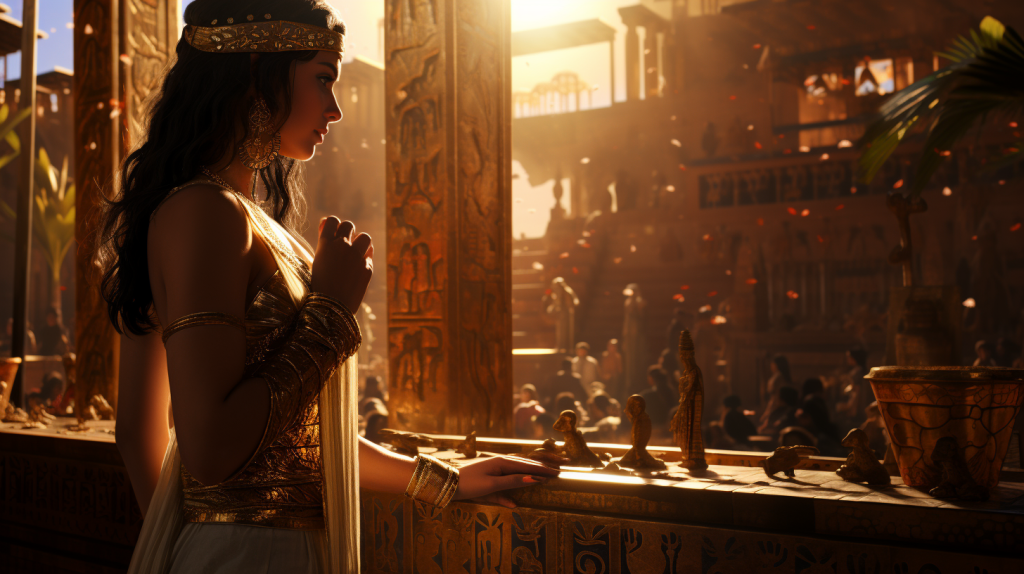
Why does the fashion of ancient Egypt continue to fascinate us? Is it the luxurious linen that draped the bodies of both the elite and the commoners? Is it the intricate jewelry that told tales of power, divinity, and love? Or is it the way fashion served as a nuanced language, a reflection of one’s status, beliefs, and even aspirations? As we journey through this exploration, each layer we peel back will reveal another facet of the complex gem that is Egyptian fashion. 🌟
So, fasten your seatbelts—or should I say, tighten your bejeweled collars—as we embark on this enlightening voyage down the Nile, a river that has witnessed the flow of time and fashion alike. 🚤
The Sands of Time: Tracing the Geographical and Cultural Threads of Egyptian Fashion 🌍
As we embark on this journey through the annals of Egyptian fashion, it’s crucial to first understand the canvas upon which this intricate tapestry was woven. The geographical and cultural landscape of ancient Egypt played a pivotal role in shaping the fashion choices of its inhabitants. Let’s delve into the elements that set the stage for this fascinating fashion narrative.
The Gift of the Nile
The Nile River was the lifeblood of ancient Egypt, providing not just water but also fertile soil that made agriculture possible. The river’s annual flooding deposited rich silt along its banks, allowing for the cultivation of flax plants, the raw material for linen. This abundance of natural resources influenced the types of fabrics used in Egyptian clothing.

The Desert’s Influence
While the Nile provided fertility, the surrounding desert offered protection. The isolation created by the desert helped preserve Egypt’s unique cultural identity, including its fashion. The hot, dry climate also influenced the choice of lightweight, breathable fabrics like linen.
The Pantheon of Gods
Fashion in ancient Egypt was deeply intertwined with religious beliefs. Garments often featured symbols and motifs associated with gods and goddesses, like the Eye of Horus for protection or the Ankh for eternal life. These religious elements were not just decorative; they served a functional purpose, acting as talismans or amulets.
The Melting Pot of Cultures
Ancient Egypt was a crossroads of various cultures, thanks to its strategic location and extensive trade networks. This cultural melting pot enriched Egyptian fashion, introducing new fabrics, colors, and styles from other lands. Whether it was the intricate beadwork from Nubia or the luxurious silks from the East, foreign influences left their mark on Egyptian fashion.
The Royal Standard
The Pharaohs and the royal court set the fashion trends of the time. Their opulent garments and extravagant accessories were emulated by the elite, creating a ripple effect that trickled down to the commoners. However, it’s essential to note that fashion was not just a frivolity for the royals; it was a statement of power, divinity, and authority.
Linen and Life: The Fabric that Draped a Civilization 🌿
When we think of ancient Egyptian fashion, the first thing that often comes to mind is the iconic linen garments that graced the bodies of pharaohs and peasants alike. Linen was more than just a fabric; it was a symbol of purity, a reflection of the climate, and a testament to Egyptian ingenuity. Let’s unravel the threads that make linen the star fabric of ancient Egypt.
The Flax Connection
Flax plants were the raw material for linen, and they thrived in the fertile soil along the Nile River. The process of turning flax into linen was labor-intensive, involving several steps from harvesting to weaving. Despite the effort required, the end result was a fabric that was both durable and breathable, making it ideal for Egypt’s hot climate.
A Fabric for All Classes
While it’s easy to associate linen with the opulence of pharaohs and nobles, it was a fabric that transcended social classes. The quality of the linen and the complexity of the garment varied according to one’s social standing. For example, the elite might wear finely woven linen that was almost transparent, while commoners wore coarser, thicker linen.
The Art of Draping
The Egyptians were masters of the art of draping. Garments were often large pieces of fabric skillfully wrapped around the body in various styles. Men typically wore a type of kilt or skirt, while women donned dresses with straps or sleeves. The styles evolved over time but always showcased the fabric’s natural beauty.
Symbolism and Rituals
Linen was not just a practical choice; it was steeped in symbolism. The fabric was considered pure and was thus used in religious rituals and ceremonies. Priests wore garments made of the finest linen when performing religious rites, and linen was also used for mummification, wrapping the deceased to assist in their journey to the afterlife.
Sustainability and Innovation
The ancient Egyptians were ahead of their time in terms of sustainability. Leftover flax fibers were used for other purposes, like making ropes or mats. This zero-waste approach is a lesson in sustainability that resonates even today.
Adornments of the Divine: The Sparkling World of Egyptian Jewelry and Accessories 💎
If linen was the canvas of ancient Egyptian fashion, then jewelry and accessories were the brushstrokes that completed the masterpiece. These weren’t mere trinkets or baubles; they were expressions of identity, status, and belief. Let’s delve into the intricate world of ancient Egyptian jewelry and accessories to understand their significance and enduring allure.
The Material World: Gold, Gemstones, and More
In ancient Egypt, the materials used for jewelry were not just chosen for their aesthetic appeal but also for their symbolic meanings. Gold, considered the “flesh of the gods,” was a popular choice for its imperishable nature. Gemstones like lapis lazuli, turquoise, and carnelian were favored for their vibrant colors and were believed to possess protective qualities.
The Craftsmanship: An Art Form in Itself
The artistry involved in creating these pieces was nothing short of extraordinary. Techniques like filigree, granulation, and cloisonné were used to create intricate designs. Whether it was a simple amulet or a complex collar necklace, each piece was a work of art that required immense skill and precision.
Everyday Elegance: Jewelry for the Masses
While the elite adorned themselves with extravagant pieces, everyday Egyptians also wore simpler forms of jewelry. Beaded necklaces, anklets, and even hair accessories were common among the general populace. These pieces, often made from less expensive materials like faience or copper, were still crafted with a high level of skill.
Sacred Symbols: Amulets and Talismans
Jewelry in ancient Egypt often served a purpose beyond mere decoration. Amulets and talismans featuring symbols like the Ankh or the Eye of Horus were worn for protection and good fortune. These weren’t just fashion statements; they were deeply rooted in the religious and cultural beliefs of the time.
The Royal Touch: Jewelry as a Symbol of Power
For the pharaohs and the nobility, jewelry was a symbol of divine authority and power. Crowns, diadems, and other headpieces were not just ornamental but were laden with symbolism. The Uraeus, or the rearing cobra, often featured on royal headgear, symbolized the pharaoh’s dominion over the lands of Upper and Lower Egypt.
Crowning Glory: The Intricate World of Egyptian Headwear and Wigs 👑
In the grand tapestry of ancient Egyptian fashion, headwear and wigs hold a special place. These weren’t just accessories; they were statements of social standing, religious affiliation, and even personal style. Let’s explore the fascinating variety and significance of what adorned the heads of ancient Egyptians.
The Royal Crowns: More Than Just Headgear
In ancient Egypt, the crown was not merely a decorative accessory; it was a potent symbol of authority and divine right. Different types of crowns were worn to signify various aspects of governance and ritual. The “Hedjet,” the White Crown, represented Upper Egypt, while the “Deshret,” the Red Crown, symbolized Lower Egypt. When combined, they formed the “Pschent,” representing the unity of the two lands.
The Everyday Headwear: Practical Yet Stylish
For the common folk, headwear was often more about practicality, especially against the harsh sun. Simple headcloths, leather caps, and straw hats were common. However, that didn’t mean they were devoid of style. These everyday pieces were often adorned with simple embroidery or beading, adding a touch of elegance to their functional nature.
Wigs: A Fashionable Necessity
Wigs were an integral part of ancient Egyptian fashion, worn by men and women alike. Made from human hair, sheep’s wool, or even palm fibers, wigs served multiple purposes. They offered protection from the sun, were easier to maintain than natural hair, and could be elaborately styled for special occasions.
Religious and Ceremonial Headwear
In the realm of the divine, headwear took on even more significant roles. Priests and priestesses wore specific types of headgear during religious ceremonies, often designed to emulate the gods they served. For instance, a priest serving the goddess Hathor might wear a headdress shaped like a cow’s head, symbolizing the deity.
The Art of Adornment: Accessories for the Head
Beyond crowns, hats, and wigs, the ancient Egyptians also enjoyed adorning their heads with various accessories. Floral wreaths, diadems, and even perfumed cones made of animal fat were used on special occasions. These additional touches were not just decorative but often had symbolic or practical purposes, such as the perfumed cones that melted to release a pleasant fragrance.
Sole Expressions: The Understated Elegance of Egyptian Footwear 👣
In a culture as rich and diverse as ancient Egypt, even the most seemingly mundane aspects of life carry deep significance. Footwear, often overlooked in the grand scheme of fashion history, is no exception. From the simple sandals of the common folk to the ornate shoes of the elite, let’s step into the world of ancient Egyptian footwear.
The Humble Sandal: A Staple for the Masses
Sandals were the most common form of footwear in ancient Egypt, primarily because they were well-suited for the hot, sandy environment. Made from materials like papyrus reeds, leather, or palm leaves, these sandals were both functional and affordable. The design was simple: a flat sole with a V-shaped thong that passed between the first and second toes.
The Elite Feet: Luxury in Every Step
For the upper echelons of society, footwear was an opportunity to display wealth and status. Sandals for the elite were crafted from finer materials like high-quality leather and were often dyed in vibrant colors. Some even featured intricate beadwork or gold leaf detailing, transforming a simple sandal into a work of art.
Footwear in Religious Contexts
In religious ceremonies, the choice of footwear was highly symbolic. Priests and priestesses often went barefoot to signify purity when entering sacred spaces. However, special ceremonial sandals made of gold or silver were sometimes worn during specific rites or processions, symbolizing the wearer’s elevated status within the religious hierarchy.
Occupational Footwear: Form Follows Function
Footwear also varied according to occupation. Farmers, for instance, needed sturdy, durable sandals to navigate the muddy banks of the Nile, while soldiers required sandals with upturned toes for better grip during combat. These variations in design were not just stylistic choices but adaptations to the practical needs of daily life.
The Evolution of Style: Fashion Meets Function
Over the centuries, Egyptian footwear styles evolved, influenced by trade, conquest, and cultural exchange. New materials and designs were introduced, such as boots and closed-toe shoes, especially during periods of foreign rule. However, the fundamental principles of comfort, functionality, and symbolism remained constant, making Egyptian footwear a fascinating subject of study.
Painted Perfection: The Sacred and Sensual World of Egyptian Cosmetics and Beauty Rituals 💄
In ancient Egypt, beauty was not merely skin deep; it was a complex interplay of the physical, the spiritual, and the symbolic. Cosmetics and beauty rituals were an integral part of daily life, transcending gender, age, and social status. Let’s delve into the fascinating practices that made the Egyptians one of history’s most aesthetically conscious people.
The Palette of the Gods: Sacred Ingredients
Cosmetics in ancient Egypt were not just about enhancing physical attributes; they were deeply rooted in spiritual beliefs. Ingredients like kohl, used for lining the eyes, were believed to have protective properties. Green malachite and black galena were often used in eye makeup, not just for their vibrant colors but also for their supposed magical and medicinal qualities.
The Daily Ritual: More Than Skin-Deep
Applying cosmetics was not a hasty affair but a ritualistic process. Men and women, regardless of their social standing, took time to apply makeup as part of their daily routine. This ritual was not just about looking good; it was a form of self-care that prepared the individual for the day ahead.
Cosmetics for the Elite: A Mark of Status
For the upper classes, cosmetics were a way to display wealth and status. The rich could afford cosmetics made from imported ingredients like red ochre from the Arabian Peninsula. These high-quality cosmetics were stored in intricately designed cosmetic jars, often made of alabaster or other precious materials.
Beauty in the Afterlife: Cosmetics for Eternity
The importance of cosmetics extended into the afterlife. Tombs of the wealthy often contained cosmetic utensils and makeup, indicating the belief that beauty rituals would continue in the realm of the gods. This practice underscores the deeply ingrained cultural significance of cosmetics in ancient Egyptian society.
Gender Fluidity in Beauty: Breaking the Mold
In a break from many other ancient cultures, Egyptian men also actively participated in beauty rituals. They wore makeup, perfumed their bodies, and even used hair dye. This gender-fluid approach to cosmetics challenges our modern perceptions and adds another layer of complexity to our understanding of ancient Egyptian culture.
Threads of Time: The Intricate Craft of Egyptian Textile Arts and Embroidery 🧵
In the rich tapestry of ancient Egyptian culture, the textile arts hold a place of honor. Far from being mere functional items, textiles in ancient Egypt were a form of artistic expression, a display of technical skill, and a reflection of social status. Let’s weave our way through the fascinating world of Egyptian textile arts and embroidery.
The Fabric of Society: Linen as a Canvas
As we’ve already explored, linen was the primary fabric used in ancient Egyptian textiles. But it was more than just a material; it was a canvas for artistic expression. The quality of the linen often served as an indicator of the wearer’s social status, with the elite opting for finely woven, almost transparent fabrics.
The Art of Embroidery: Stitching Stories
Embroidery was a highly valued skill, transforming plain fabric into intricate works of art. Using colored threads, artisans would create complex patterns and even narrative scenes. This art form was not just decorative but often symbolic, with specific motifs representing religious or cultural themes.
Dyeing to Impress: The Color Palette
Color was an essential aspect of Egyptian textiles, and the process of dyeing was a specialized skill. Natural dyes were made from plants, minerals, and even some insects. The choice of colors was not arbitrary; each hue had symbolic significance. For example, blue represented the sky and the divine, while red symbolized power and vitality.
Patterns and Motifs: A Language in Thread
The patterns embroidered or woven into textiles were not random; they were a form of visual language. Geometric patterns, floral motifs, and depictions of gods and goddesses were common. These patterns served multiple purposes: they were aesthetically pleasing, carried symbolic meaning, and often told stories or conveyed messages.
From Loom to Tomb: Textiles in the Afterlife
Textiles also had a sacred function, particularly in the context of death and the afterlife. The mummification process involved wrapping the body in layers of linen, sometimes embroidered with protective spells or images of deities. This practice underscores the spiritual significance of textiles in ancient Egyptian culture.
Little Pharaohs: The Whimsical World of Ancient Egyptian Children’s Fashion 👶
When we think of ancient Egyptian fashion, our minds often drift to the grandeur of pharaohs and the elegance of queens. But what about the little ones? Yes, children in ancient Egypt also had their own unique styles and fashion norms. Let’s take a delightful journey into the world of pint-sized fashion in the Nile Valley.
Miniature Majesty: Royal Children’s Attire
Even in childhood, the young members of the royal family were dressed to impress. Their garments were often miniature versions of adult royal attire, complete with the finest linen and intricate detailing. Gold jewelry, like small amulets and bracelets, were common accessories, emphasizing their royal status from a young age.
Everyday Elegance: Commoner Children’s Fashion
For the children of commoners, fashion was more about function than opulence. However, that didn’t mean it lacked style. Simple tunics made of coarse linen were the norm, often adorned with colorful threads or small beads. Footwear was optional and largely depended on the terrain and activity.
Rituals and Milestones: Fashion for Special Occasions
Just like adults, children had special outfits for significant life events and religious ceremonies. For example, during the “Sebou,” a ceremony marking the seventh day after a child’s birth, the baby would be dressed in new clothes, often gifted by relatives, to mark this important milestone.
Playful Adornments: Accessories and Toys
Children’s fashion wasn’t just about clothes; it also included playful accessories and even toys. Small amulets in the shape of animals or gods were popular, believed to offer protection or good luck. Miniature weapons for boys and dolls for girls were common toys that also served as decorative items.
Learning Through Dress: Educational Aspects
Believe it or not, fashion also had an educational role in children’s lives. Through the act of dressing and the types of garments worn, children learned about social roles, religious practices, and even basic skills like tying knots and fastening clasps.
Gleaming Echoes: The Timeless Allure of Ancient Egyptian Jewelry and Adornments 💎
In a civilization as aesthetically driven as ancient Egypt, jewelry was far more than mere ornamentation. It was a statement of power, a talisman of protection, and a work of art. Let’s delve into the glittering world of Egyptian jewelry and adornments, where each piece tells a story as rich as the civilization itself.
Symbols of Power: Royal Jewelry
For the pharaohs and queens, jewelry was an integral part of their royal attire. These pieces were not just decorative but symbolic, often imbued with religious and political significance. Crowns, diadems, and collars made of gold and precious stones like lapis lazuli and turquoise were common. These materials were not just chosen for their beauty but for their symbolic meanings; gold represented the sun and divinity, while lapis lazuli symbolized the heavens.
Everyday Elegance: Jewelry of the Common Folk
While the common people couldn’t afford the luxurious materials used in royal jewelry, they had their own versions made from more accessible materials like copper, bone, and colored glass beads. These pieces, though simpler, were no less meaningful. Amulets of gods and goddesses, for example, were worn for protection and good fortune.
Sacred Adornments: Religious Significance
Jewelry also played a role in religious practices. Priests and priestesses wore specific pieces during rituals, often representing gods or sacred animals like the ankh for life or the djed pillar for stability. These pieces were believed to invoke the gods’ favor and were an essential part of religious ceremonies.
The Art of Craftsmanship: Techniques and Materials
The craftsmanship involved in creating these pieces was extraordinary. Techniques like cloisonné, in which small compartments were created on a metal surface and filled with enamel or stones, were used. The choice of materials was also significant; gemstones were chosen not just for their beauty but for their supposed magical properties.
Jewelry for Eternity: Adornments in the Afterlife
The belief in an afterlife meant that jewelry was not just for the living. Tombs often contained a variety of jewelry pieces intended for use in the afterlife. These could range from simple amulets for protection to elaborate pieces that signified the deceased’s status and achievements.
Crowning Glory: The Intricacies of Ancient Egyptian Hairstyles and Headdresses 👑
In the land of pyramids and sphinxes, where appearance was a form of language, hairstyles and headdresses held a special place. They were not just about aesthetics; they were laden with symbolism, cultural significance, and even religious beliefs. Let’s untangle the fascinating history of hairstyles and headdresses in ancient Egypt.
A Royal Affair: Pharaohs and Their Crowns
The crowns worn by Egyptian pharaohs were not mere accessories; they were potent symbols of authority and divine mandate. The “Nemes” headdress, famously seen on Tutankhamun’s golden mask, was one such crown. Made of striped cloth that hung down the back and sides, it was often paired with a uraeus, the rearing cobra symbolizing the king’s readiness to strike at enemies.
Tresses and Locks: Everyday Hairstyles
For the common folk, hairstyles were simpler but still significant. Men typically wore their hair short or shaved their heads to cope with the hot climate, while women often had longer hair styled in braids or twists. Wigs made from human hair or plant fibers were also popular, especially for special occasions.
The Spiritual Tress: Religious and Ritualistic Hairstyles
In religious contexts, hairstyles took on even greater significance. Priests often shaved their heads as a sign of purity and devotion. During religious festivals, specific hairstyles and headdresses were worn to honor particular gods or goddesses. For example, during the Feast of Hathor, women would wear their hair in cowrie shell-shaped locks to honor the goddess of love and motherhood.
Headdresses for All: Social and Gender Norms
Headdresses were not exclusive to the elite; they were worn by people from all walks of life. However, the materials and complexity varied according to social status. Men and women both wore headdresses, but the styles and symbolism could differ. For instance, men’s headdresses often included feathers or animal motifs, while women’s were more likely to feature floral designs.
Eternal Styles: Hairstyles in the Afterlife
Beliefs about the afterlife influenced hairstyles even in death. Mummies have been found with elaborate wigs and hairpieces, indicating the importance of carrying one’s style into the next life. These wigs were often styled in a manner that was considered eternally fashionable, ensuring the deceased would look their best for eternity.
Sole Stories: The Fascinating World of Ancient Egyptian Footwear and Fashion Accessories 👠
In a culture where every thread and trinket had a tale to tell, the story of ancient Egyptian footwear and fashion accessories is a narrative worth walking through. From the soles that touched the fertile Nile banks to the amulets that adorned the necks of both the living and the dead, each item was a chapter in the grand epic of Egyptian life.
Sandals of the Nile: Everyday Footwear
The most common type of footwear in ancient Egypt was the sandal. Made primarily from papyrus or palm leaves, these sandals were both practical and comfortable for the hot, sandy environment. Intricately woven, they showcased the craftsmanship of the time. For the wealthier classes, leather sandals with ornate designs were the norm.
Royal Steps: Footwear of the Elite
In stark contrast to the commoners, the footwear of the Egyptian elite was a statement of luxury and power. Gold, silver, and precious stones were often incorporated into the designs. Pharaohs and high-ranking officials would have personalized inscriptions on the soles, sometimes depicting subdued enemies, symbolizing their dominion with every step.
Beyond the Neck: Collars and Necklaces
Jewelry wasn’t confined to the ears and wrists; collars and necklaces were also significant fashion accessories. These items were often made from rows of beads in various shapes and colors, forming intricate patterns. Collars were especially prominent during religious ceremonies and were sometimes offered to gods as votive gifts.
Amulets and Talismans: Symbols of Protection and Power
Amulets were more than just decorative; they were believed to offer protection and bring good fortune. Made from a variety of materials including faience, these small items were often shaped like gods, animals, or symbols like the ankh or the Eye of Horus. They were worn around the neck, sewn into clothing, or even placed among mummy wrappings.
Utility and Aesthetics: Cosmetic Accessories
Ancient Egyptians took their beauty routines seriously, and this was reflected in their cosmetic accessories. Items like kohl pots for eyeliner, perfume jars, and intricately carved combs were common. These were often made from materials like alabaster or glass and were sometimes inlaid with gold or silver.
Woven Wonders: The Fabric of Ancient Egyptian Fashion 🧵
In the realm of ancient Egyptian fashion, the fabrics were not just the canvas upon which the art of clothing was painted; they were the very threads that wove together society, culture, and individual identity. Let’s unravel the rich tapestry of textiles that adorned the bodies and enriched the lives of the people along the Nile.
Linen: The Fabric of Life
Linen was the most commonly used fabric in ancient Egypt, spun from the fibers of the flax plant. It was breathable, easy to dye, and well-suited for the hot, dry climate. The quality of linen varied, with the finest threads reserved for the garments of the elite. Linen was so integral to daily life that it was even used as a form of currency.
Wool: The Outsider Fabric
Unlike linen, wool was less commonly used, mainly because it was considered impure in religious contexts. However, it was still used for specific purposes like blankets and outerwear, especially in the colder regions and during wintertime.
Cotton and Imported Fabrics: A Touch of Luxury
Cotton was a luxury in ancient Egypt, often imported from India and other distant lands. It was softer and more absorbent than linen but was generally reserved for the elite due to its cost. Other imported fabrics like silk from China were also highly prized but were extremely rare.
Dyes and Patterns: The Color of Fashion
Natural dyes were used to add vibrant colors to fabrics. Plants, minerals, and even some insects were sources of these dyes. Patterns were either woven into the fabric or applied afterward using stamps or brushes. Stripes and geometric patterns were popular, as were floral motifs.
From Loom to Room: The Craftsmanship Behind the Fabrics
The process of making these textiles was labor-intensive and required skilled craftsmanship. Spinning, weaving, and dyeing were generally done by women in their homes or in small workshops. The looms used were simple but effective, and the techniques have been passed down through generations, a testament to their enduring quality.
Timeless Threads: The Eternal Elegance of the Nile 🌿
As we come to the end of this captivating journey through the fashion landscape of ancient Egypt, it’s clear that the elegance of the Nile Valley is not just a relic of the past, but a timeless marvel that continues to inspire and intrigue. From the humble sandals that tread upon the earth to the intricate collars that graced royal necks, each piece tells a story of a civilization deeply connected to its environment, beliefs, and social structures.
The fabrics that draped the bodies of the ancient Egyptians were not mere garments but expressions of identity, status, and even spirituality. Linen, wool, and exotic imported fabrics like cotton and silk were more than just materials; they were threads in the intricate tapestry of Egyptian life.
The colors and patterns that adorned these textiles were not random choices but deliberate expressions of cultural values, religious beliefs, and individual tastes. They were the brushstrokes on the canvas of Egyptian society, each hue and design adding depth and dimension to the overall picture.
In a world that is constantly changing, the fashion of ancient Egypt serves as a poignant reminder that some things remain timeless. The elegance, craftsmanship, and profound cultural significance of these historical garments and accessories continue to captivate us, offering a window into a world both incredibly distant and surprisingly close to our own hearts.
Thank you for joining me on this enlightening expedition. As we close this chapter, let’s carry forward the wisdom and beauty we’ve uncovered, weaving them into the fabric of our own lives.
Further Reading and Resources 📚
For those who are keen to delve even deeper into the fascinating world of ancient Egyptian fashion, here are some recommended resources that will enrich your understanding and satiate your curiosity:
- Books and Journals:
- “Textiles and Clothing of Ancient Egypt” by Rosalind Hall
- “Fashion in Ancient Egypt” by Florence Dunn Friedman
- “The Complete Gods and Goddesses of Ancient Egypt” by Richard H. Wilkinson
- Online Articles and Websites:
- Documentaries and Video Lectures:
- “The Hidden Secrets of Egyptian Textiles” – Available on YouTube
- “Dressing The Egyptian Way” – Available on Netflix
- “Ancient Egyptian Clothing and Jewelry” – Available on Amazon Prime
- Museums and Exhibitions:
Feel free to explore these resources at your leisure. Each one offers a unique perspective and a wealth of information that complements what we’ve discussed in this blog series.


